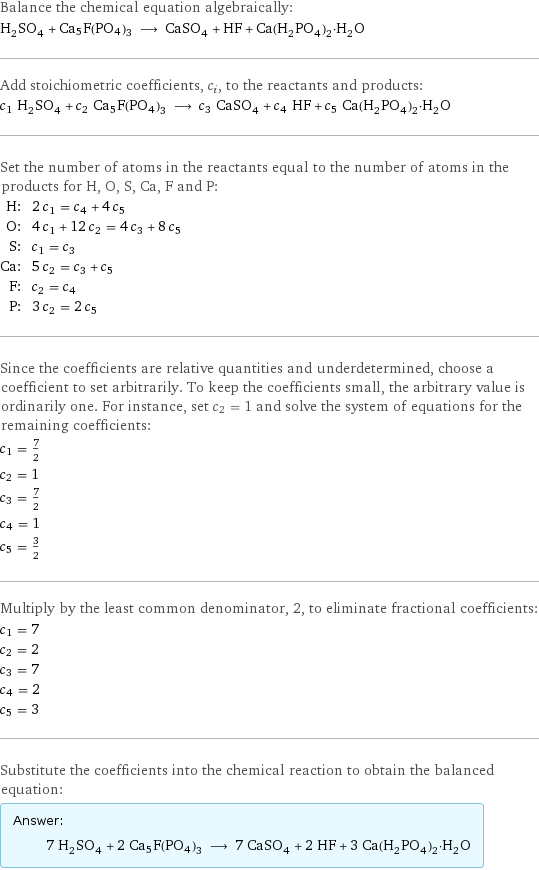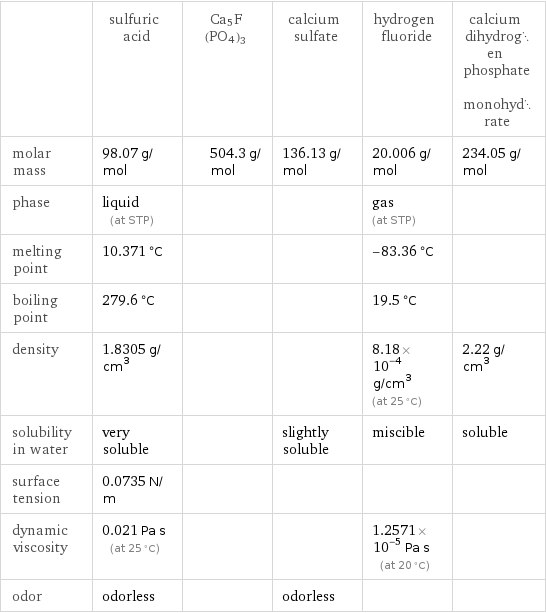Input interpretation

H_2SO_4 sulfuric acid + Ca5F(PO4)3 ⟶ CaSO_4 calcium sulfate + HF hydrogen fluoride + Ca(H_2PO_4)_2·H_2O calcium dihydrogen phosphate monohydrate
Balanced equation

Balance the chemical equation algebraically: H_2SO_4 + Ca5F(PO4)3 ⟶ CaSO_4 + HF + Ca(H_2PO_4)_2·H_2O Add stoichiometric coefficients, c_i, to the reactants and products: c_1 H_2SO_4 + c_2 Ca5F(PO4)3 ⟶ c_3 CaSO_4 + c_4 HF + c_5 Ca(H_2PO_4)_2·H_2O Set the number of atoms in the reactants equal to the number of atoms in the products for H, O, S, Ca, F and P: H: | 2 c_1 = c_4 + 4 c_5 O: | 4 c_1 + 12 c_2 = 4 c_3 + 8 c_5 S: | c_1 = c_3 Ca: | 5 c_2 = c_3 + c_5 F: | c_2 = c_4 P: | 3 c_2 = 2 c_5 Since the coefficients are relative quantities and underdetermined, choose a coefficient to set arbitrarily. To keep the coefficients small, the arbitrary value is ordinarily one. For instance, set c_2 = 1 and solve the system of equations for the remaining coefficients: c_1 = 7/2 c_2 = 1 c_3 = 7/2 c_4 = 1 c_5 = 3/2 Multiply by the least common denominator, 2, to eliminate fractional coefficients: c_1 = 7 c_2 = 2 c_3 = 7 c_4 = 2 c_5 = 3 Substitute the coefficients into the chemical reaction to obtain the balanced equation: Answer: | | 7 H_2SO_4 + 2 Ca5F(PO4)3 ⟶ 7 CaSO_4 + 2 HF + 3 Ca(H_2PO_4)_2·H_2O
Structures

+ Ca5F(PO4)3 ⟶ + +
Names

sulfuric acid + Ca5F(PO4)3 ⟶ calcium sulfate + hydrogen fluoride + calcium dihydrogen phosphate monohydrate
Equilibrium constant
![Construct the equilibrium constant, K, expression for: H_2SO_4 + Ca5F(PO4)3 ⟶ CaSO_4 + HF + Ca(H_2PO_4)_2·H_2O Plan: • Balance the chemical equation. • Determine the stoichiometric numbers. • Assemble the activity expression for each chemical species. • Use the activity expressions to build the equilibrium constant expression. Write the balanced chemical equation: 7 H_2SO_4 + 2 Ca5F(PO4)3 ⟶ 7 CaSO_4 + 2 HF + 3 Ca(H_2PO_4)_2·H_2O Assign stoichiometric numbers, ν_i, using the stoichiometric coefficients, c_i, from the balanced chemical equation in the following manner: ν_i = -c_i for reactants and ν_i = c_i for products: chemical species | c_i | ν_i H_2SO_4 | 7 | -7 Ca5F(PO4)3 | 2 | -2 CaSO_4 | 7 | 7 HF | 2 | 2 Ca(H_2PO_4)_2·H_2O | 3 | 3 Assemble the activity expressions accounting for the state of matter and ν_i: chemical species | c_i | ν_i | activity expression H_2SO_4 | 7 | -7 | ([H2SO4])^(-7) Ca5F(PO4)3 | 2 | -2 | ([Ca5F(PO4)3])^(-2) CaSO_4 | 7 | 7 | ([CaSO4])^7 HF | 2 | 2 | ([HF])^2 Ca(H_2PO_4)_2·H_2O | 3 | 3 | ([Ca(H2PO4)2·H2O])^3 The equilibrium constant symbol in the concentration basis is: K_c Mulitply the activity expressions to arrive at the K_c expression: Answer: | | K_c = ([H2SO4])^(-7) ([Ca5F(PO4)3])^(-2) ([CaSO4])^7 ([HF])^2 ([Ca(H2PO4)2·H2O])^3 = (([CaSO4])^7 ([HF])^2 ([Ca(H2PO4)2·H2O])^3)/(([H2SO4])^7 ([Ca5F(PO4)3])^2)](../image_source/31c7c823ae6193a1f1e60ed06605e355.png)
Construct the equilibrium constant, K, expression for: H_2SO_4 + Ca5F(PO4)3 ⟶ CaSO_4 + HF + Ca(H_2PO_4)_2·H_2O Plan: • Balance the chemical equation. • Determine the stoichiometric numbers. • Assemble the activity expression for each chemical species. • Use the activity expressions to build the equilibrium constant expression. Write the balanced chemical equation: 7 H_2SO_4 + 2 Ca5F(PO4)3 ⟶ 7 CaSO_4 + 2 HF + 3 Ca(H_2PO_4)_2·H_2O Assign stoichiometric numbers, ν_i, using the stoichiometric coefficients, c_i, from the balanced chemical equation in the following manner: ν_i = -c_i for reactants and ν_i = c_i for products: chemical species | c_i | ν_i H_2SO_4 | 7 | -7 Ca5F(PO4)3 | 2 | -2 CaSO_4 | 7 | 7 HF | 2 | 2 Ca(H_2PO_4)_2·H_2O | 3 | 3 Assemble the activity expressions accounting for the state of matter and ν_i: chemical species | c_i | ν_i | activity expression H_2SO_4 | 7 | -7 | ([H2SO4])^(-7) Ca5F(PO4)3 | 2 | -2 | ([Ca5F(PO4)3])^(-2) CaSO_4 | 7 | 7 | ([CaSO4])^7 HF | 2 | 2 | ([HF])^2 Ca(H_2PO_4)_2·H_2O | 3 | 3 | ([Ca(H2PO4)2·H2O])^3 The equilibrium constant symbol in the concentration basis is: K_c Mulitply the activity expressions to arrive at the K_c expression: Answer: | | K_c = ([H2SO4])^(-7) ([Ca5F(PO4)3])^(-2) ([CaSO4])^7 ([HF])^2 ([Ca(H2PO4)2·H2O])^3 = (([CaSO4])^7 ([HF])^2 ([Ca(H2PO4)2·H2O])^3)/(([H2SO4])^7 ([Ca5F(PO4)3])^2)
Rate of reaction
![Construct the rate of reaction expression for: H_2SO_4 + Ca5F(PO4)3 ⟶ CaSO_4 + HF + Ca(H_2PO_4)_2·H_2O Plan: • Balance the chemical equation. • Determine the stoichiometric numbers. • Assemble the rate term for each chemical species. • Write the rate of reaction expression. Write the balanced chemical equation: 7 H_2SO_4 + 2 Ca5F(PO4)3 ⟶ 7 CaSO_4 + 2 HF + 3 Ca(H_2PO_4)_2·H_2O Assign stoichiometric numbers, ν_i, using the stoichiometric coefficients, c_i, from the balanced chemical equation in the following manner: ν_i = -c_i for reactants and ν_i = c_i for products: chemical species | c_i | ν_i H_2SO_4 | 7 | -7 Ca5F(PO4)3 | 2 | -2 CaSO_4 | 7 | 7 HF | 2 | 2 Ca(H_2PO_4)_2·H_2O | 3 | 3 The rate term for each chemical species, B_i, is 1/ν_i(Δ[B_i])/(Δt) where [B_i] is the amount concentration and t is time: chemical species | c_i | ν_i | rate term H_2SO_4 | 7 | -7 | -1/7 (Δ[H2SO4])/(Δt) Ca5F(PO4)3 | 2 | -2 | -1/2 (Δ[Ca5F(PO4)3])/(Δt) CaSO_4 | 7 | 7 | 1/7 (Δ[CaSO4])/(Δt) HF | 2 | 2 | 1/2 (Δ[HF])/(Δt) Ca(H_2PO_4)_2·H_2O | 3 | 3 | 1/3 (Δ[Ca(H2PO4)2·H2O])/(Δt) (for infinitesimal rate of change, replace Δ with d) Set the rate terms equal to each other to arrive at the rate expression: Answer: | | rate = -1/7 (Δ[H2SO4])/(Δt) = -1/2 (Δ[Ca5F(PO4)3])/(Δt) = 1/7 (Δ[CaSO4])/(Δt) = 1/2 (Δ[HF])/(Δt) = 1/3 (Δ[Ca(H2PO4)2·H2O])/(Δt) (assuming constant volume and no accumulation of intermediates or side products)](../image_source/843dc7d9c04d3bfc113b561a2da0c0a0.png)
Construct the rate of reaction expression for: H_2SO_4 + Ca5F(PO4)3 ⟶ CaSO_4 + HF + Ca(H_2PO_4)_2·H_2O Plan: • Balance the chemical equation. • Determine the stoichiometric numbers. • Assemble the rate term for each chemical species. • Write the rate of reaction expression. Write the balanced chemical equation: 7 H_2SO_4 + 2 Ca5F(PO4)3 ⟶ 7 CaSO_4 + 2 HF + 3 Ca(H_2PO_4)_2·H_2O Assign stoichiometric numbers, ν_i, using the stoichiometric coefficients, c_i, from the balanced chemical equation in the following manner: ν_i = -c_i for reactants and ν_i = c_i for products: chemical species | c_i | ν_i H_2SO_4 | 7 | -7 Ca5F(PO4)3 | 2 | -2 CaSO_4 | 7 | 7 HF | 2 | 2 Ca(H_2PO_4)_2·H_2O | 3 | 3 The rate term for each chemical species, B_i, is 1/ν_i(Δ[B_i])/(Δt) where [B_i] is the amount concentration and t is time: chemical species | c_i | ν_i | rate term H_2SO_4 | 7 | -7 | -1/7 (Δ[H2SO4])/(Δt) Ca5F(PO4)3 | 2 | -2 | -1/2 (Δ[Ca5F(PO4)3])/(Δt) CaSO_4 | 7 | 7 | 1/7 (Δ[CaSO4])/(Δt) HF | 2 | 2 | 1/2 (Δ[HF])/(Δt) Ca(H_2PO_4)_2·H_2O | 3 | 3 | 1/3 (Δ[Ca(H2PO4)2·H2O])/(Δt) (for infinitesimal rate of change, replace Δ with d) Set the rate terms equal to each other to arrive at the rate expression: Answer: | | rate = -1/7 (Δ[H2SO4])/(Δt) = -1/2 (Δ[Ca5F(PO4)3])/(Δt) = 1/7 (Δ[CaSO4])/(Δt) = 1/2 (Δ[HF])/(Δt) = 1/3 (Δ[Ca(H2PO4)2·H2O])/(Δt) (assuming constant volume and no accumulation of intermediates or side products)
Chemical names and formulas

| sulfuric acid | Ca5F(PO4)3 | calcium sulfate | hydrogen fluoride | calcium dihydrogen phosphate monohydrate formula | H_2SO_4 | Ca5F(PO4)3 | CaSO_4 | HF | Ca(H_2PO_4)_2·H_2O Hill formula | H_2O_4S | Ca5FO12P3 | CaO_4S | FH | CaH_4O_8P_2 name | sulfuric acid | | calcium sulfate | hydrogen fluoride | calcium dihydrogen phosphate monohydrate IUPAC name | sulfuric acid | | calcium sulfate | hydrogen fluoride | calcium dihydrogen phosphate
Substance properties

| sulfuric acid | Ca5F(PO4)3 | calcium sulfate | hydrogen fluoride | calcium dihydrogen phosphate monohydrate molar mass | 98.07 g/mol | 504.3 g/mol | 136.13 g/mol | 20.006 g/mol | 234.05 g/mol phase | liquid (at STP) | | | gas (at STP) | melting point | 10.371 °C | | | -83.36 °C | boiling point | 279.6 °C | | | 19.5 °C | density | 1.8305 g/cm^3 | | | 8.18×10^-4 g/cm^3 (at 25 °C) | 2.22 g/cm^3 solubility in water | very soluble | | slightly soluble | miscible | soluble surface tension | 0.0735 N/m | | | | dynamic viscosity | 0.021 Pa s (at 25 °C) | | | 1.2571×10^-5 Pa s (at 20 °C) | odor | odorless | | odorless | |
Units
